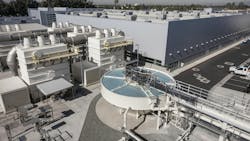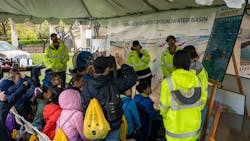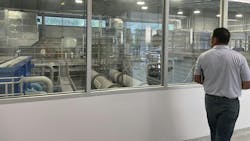Four considerations for water reuse in your community
With much of the country facing water scarcity issues, concerns with availability of reliable drinking water sources, resilience from climate change and natural disasters, and the numerous upcoming regulatory changes, water agencies and communities are increasingly looking at ways to diversify their water portfolio and protect their existing supplies through reuse. This may seem like an insurmountable task, especially to an agency that does not currently have a reuse facility in its portfolio, but with the right support, any agency can make this dream a reality.
1. Identify the need and cost impacts for water reuse
First, water agencies must determine the need for reuse applications in their community. Engineering firms and consultants can help identify potential customers and users, whether that is high-water-use industrial applications, such as semiconductor manufacturing or food and beverage suppliers; irrigation for golf courses or parks; agricultural use; or, at the most advanced level, potable reuse.
There are also long-term considerations, including future population growth and capacity demands; reliability of supplies; planning for natural disasters, etc. Measuring the need and demand against the available source supply and risk profile for reliability and resilience will help develop a strategy for implementing reuse into an agency’s program or master plan.
There is obviously an economic impact that must be considered as well. By determining what level of treatment will be required to achieve the most beneficial use and what approach to take — direct potable reuse (DPR), indirect potable reuse (IPR), recycled water, or a combination of approaches — the agency can better understand the high-level cost impacts they should expect.
The agency must then consider its ability to secure funding for any capital improvements, as well as the additional cost of operating and maintaining such changes. Ultimately, it must decide whether it is worth changing or adding to their treatment approach.
2. Examine state and local water reuse regulations
Assuming the need exists and is justifiable, the next major consideration involves a review of existing state or local regulations for achieving the target treatment goals.
For example, consider the Orange County Water District Groundwater Replenishment System (OCWD GWRS) in Fountain Valley, California. GWRS expanded from 70 million gallons per day (MGD) to 100 MGD in 2015. The need and best approach was determined to be indirect potable reuse through groundwater replenishment of the aquifer OCWD manages.
The state of California’s regulations for IPR dictate that treatment requirements, in simplistic terms, must meet the “12/10/10 Rule,” that is log removal value (LRV) targets of 12-log for virus, 10-log for Giardia, and 10-log for Cryptosporidium using three separate treatment processes and underground retention time. Log removal refers to the reduction in concentration by a factor of 10.
For instance, an LRV of 1 refers to 90% removal, an LRV of 2 refers to 99% removal, and a LRV of 3 refers to 99.9% removal. Credits for LRV are accumulated by utilizing a multi-barrier technology approach, with different processes obtaining LRV credits for virus and/or bacteria, as shown by Table 1 (see Page 26) in the case of the OCWD GWRS facility.
There are additional requirements for groundwater injection applications — such as source control, specific monitoring outcomes and the use of reverse osmosis and advanced oxidation processes as well — and based on these specific requirements and treatment goals, a water agency can assess what they need to implement into its overall program.
In the case of the OCWD GWRS facility, it achieves the IPR requirements by utilizing a treatment train consisting of membrane filtration (UF/MF), reverse osmosis (RO), ultraviolet/advanced oxidation process (UV/AOP), and underground storage time via the groundwater aquifer. The credits in Table 1 on page 26 are obtained through each of the processes.
A similar determination needs to be made for any water agency considering a potable reuse program. Reuse applications for recycled water (i.e. irrigation), are much less stringent because LRV credits are not typically needed, but a similar approach targeting water quality goals would still be used. In the case of California Recycled Water Regulations (Title 22), requirements on concentration of total coliform bacteria are used as the primary measure for classifying categories of recycled water applications.
Based on the outcomes of defining an agency’s treatment goals and selection of the appropriate process technologies, it can perform more refined estimates for expected budget impacts. Best practices suggest utilizing industry expertise from the engineering and construction communities to get the most accurate and up-to-date estimates, with market conditions changing rapidly from supply-chain disruptions, escalation impacts, new federal funding requirements and various other issues.
Supply chain issues and federal funding requirements have placed a large amount of uncertainty on availability of products. Water agencies are only now coming to grips with understanding the Build America Buy America (BABA) Act and managing extremely long lead times for items like electrical gear or PLCs. Working with design and construction partners early on in the project’s planning phase has proven to be invaluable in anticipating uncertainties with a more refined approach to value engineering, procurement and scheduling.
Table 1. Summary of pathogenic microorganism control for the OCWD GWRS
Table 1. Source: 2022-GWRS-Annual-Report
3. Build trust through communication
As a clear picture of a project’s approach, scope and cost is developed, interaction with the public should ramp up accordingly. It is important to keep the public informed of projects that may impact the community at every step of the process so that any major concerns are addressed before decisions that affect the overall project direction are made. As the approach becomes more defined, steps to perform environmental impact assessments, preparing the basis of design or project environmental reports, obtaining permits and securing funding may bring up issues that affect public perception of the project. With water recycling and reuse projects there is also an additional layer of concern for public health, which necessitates building the community’s understanding of the treatment process, comfort with the regulatory requirements and trust in the agency’s plan to operate and monitor the facilities.
There are myriad approaches to address these issues. In the case of OCWD GWRS, they not only operated a pilot system for many years at the groundbreaking Water Factory 21, which was the first advanced treatment facility to utilize RO, but a robust education and outreach program was implemented to build the public’s trust, and it ultimately earned overwhelming support for the project. They continue to provide public tours and support educational efforts for youth events and programs to increase awareness and maintain the community’s trust. Agencies like OCWD that have the available resources to provide this level of support can provide outreach and education through internal staff, but quite often, a public relations company that specializes in community engagement and, specifically water reuse issues, may be hired to help develop a strategy for communication and involvement.
Other agencies have been successful in securing the public’s backing by building demonstration facilities, as was the case with the San Diego Pure Water and Las Virgenes Pure Water programs in California and the Hampton Roads Sanitation District’s SWIFT Research Center in Virginia. As these projects become reality, many agencies also end up designing distinctive buildings to showcase major areas of the treatment process in preparation for public tours and educational opportunities, such as Water Replenishment District’s Albert Robles Center for Environmental Learning and Water Recycling (ARC) in Pico Rivera, California. This type of commitment proves an agency’s dedication to preserving confidence and can be an effective model for garnering public trust.
4. Ensure effective operation and maintenance
Finally, a major consideration for water agencies looking at implementing a reuse program must be how they will effectively operate and maintain the facility with the appropriate monitoring, optimization and compliance. As recently discussed at one of the operations focused panels at the 2024 WateReuse Annual Symposium in Denver, the key issues seem to be: availability and recruiting of skilled workers; new or not yet developed operator certification requirements for potable reuse facilities; proper training to preserve the integrity and quality of operations, maintenance and monitoring activities; and, retention of these skilled workers.
A key technical hurdle that agencies experience is how permits are being issued with respect to operator certification levels. When a new permit is issued in the case of a new or revised facility, such as during an expansion, operator certification requirements are provided or updated. OCWD experienced such an update during its latest final expansion project, where it added 30 MGD of capacity. Although OCWD already was running an IPR plant, there had been a new advanced water treatment (AWT) certification requirement issued by the California Department of Drinking Water (DDW), which oversees IPR facilities and operator requirements. In this case, OCWD was able to negotiate how many operators were required to obtain the certification and how much time they had to achieve that certification, which was necessary based on the number of existing operators without the latest certification.
To address the talent concern, many agencies have developed a social media presence for public outreach and recruitment purposes, but this is not necessarily unique to those who are contemplating a reuse facility or those with one. These efforts have expanded to programs at elementary, high school and collegiate levels, to garner interest in the water and wastewater fields in general, with the hope that a larger pool of applicants will ensue in the future. In order to recruit and retain employees, agencies are typically focusing on benefits that include financial incentives, flexible agreements and focus on good culture. These softer benefits may include paying for licenses or certifications, as OCWD provides for its employees, or having a monthly showcase and reward for employees who are exceeding expectations, as the City of Phoenix has implemented with its annual “Thank a Water Hero Day” and Pelican Award employee incentivization programs.
These key considerations for any agency looking into developing or expanding their reuse program are a good starting point, but connecting with the experts in the planning, design and construction fields is critical to creating a customized strategy for a specific approach. Utilizing the knowledge and expertise of professionals who have relevant experience will ensure a comprehensive plan and smooth process for any agency starting off their reuse endeavors.
About the Author
Naomi Jones
Naomi Jones is a Design Integration Director for McCarthy Building Companies’ national water group. She can be reached at [email protected].



